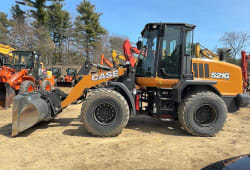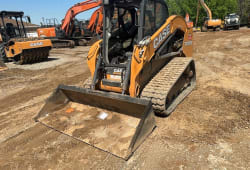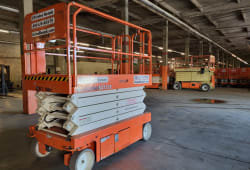Types of Concrete Pumps: Choosing the Right One
13 Min read
)
August 10, 2023
Concrete pumps have become an integral part of the construction industry, providing a reliable and efficient way to transport concrete to different locations on a construction site. With the wide range of concrete pumps available, it is crucial to choose the right one for your specific needs and requirements. In this article, we will explore the different types of concrete pumps and the factors to consider when making your selection. We will also discuss the pros and cons of each type and highlight important safety measures to ensure the smooth operation of these machines.
Understanding Concrete Pumps
Before delving into the various types of concrete pumps, it is important to understand what these machines are and their significance in construction projects.
Concrete pumps are not just ordinary machines; they are the backbone of any construction project. These powerful devices are designed to transport liquid concrete by pumping it through pipes, making the process of concrete placement efficient and precise. With their ability to pump concrete to specific locations, they have revolutionized the construction industry.
What is a Concrete Pump?
A concrete pump is a machine designed to transport liquid concrete by pumping it through pipes. It consists of a hopper, pumping system, and delivery pipes, which allow the concrete to be directed to specific locations. Concrete pumps are typically mounted on trucks or trailers for easy maneuverability and accessibility in different areas of a construction site. They play a crucial role in both small and large-scale construction projects, improving efficiency and reducing manual labor.
Concrete pumps come in various sizes and configurations, depending on the specific needs of the project. Some pumps are designed for high-rise buildings, while others are suitable for underground structures. The versatility of these machines makes them an essential tool in the construction industry.
The Importance of Concrete Pumps in Construction
The use of concrete pumps offers several advantages in construction. Firstly, they provide a faster and more precise method of concrete placement compared to traditional methods, such as using wheelbarrows or cranes. With a concrete pump, the concrete can be efficiently pumped to hard-to-reach areas, such as high-rise buildings or underground structures, saving time and effort.
Moreover, concrete pumps minimize the risk of segregation and slump loss, as the concrete is pumped directly from the mixing plant to the desired location without any delay. This ensures a uniform and consistent quality of the concrete, enhancing the overall durability and strength of the structure. Additionally, the controlled placement of concrete reduces waste and allows for better utilization of resources, resulting in cost savings.
Concrete pumps also play a crucial role in improving worker safety. By eliminating the need for manual handling of heavy concrete materials, they reduce the risk of injuries and accidents on the construction site. This not only protects the workers but also ensures that the project progresses smoothly without any disruptions.
Furthermore, concrete pumps enable construction projects to meet tight deadlines. With their efficient pumping capabilities, large volumes of concrete can be placed within a short period, allowing for faster construction progress. This is particularly beneficial in projects with strict timelines, such as infrastructure development or commercial building construction.
In addition to their efficiency and safety benefits, concrete pumps also contribute to environmental sustainability. By reducing the need for excessive transportation and minimizing material wastage, they help in conserving natural resources and reducing carbon emissions. This aligns with the growing emphasis on sustainable construction practices.
In conclusion, concrete pumps are an indispensable tool in the construction industry. Their ability to transport liquid concrete efficiently and precisely makes them an essential component of any construction project. From improving efficiency and worker safety to enhancing the overall quality of the structure, concrete pumps have revolutionized the way concrete is placed, making construction processes more streamlined and sustainable.
Different Types of Concrete Pumps
When it comes to construction projects, having the right equipment is essential. Concrete pumps are one such piece of machinery that plays a crucial role in ensuring efficient and precise concrete placement. There are different types of concrete pumps available, each designed to cater to specific construction requirements. Let's explore the three main types:
Boom Pumps
Boom pumps, also known as truck-mounted concrete pumps, are highly versatile machines equipped with a robotic arm, or boom, that can extend to various lengths and angles. This flexibility allows boom pumps to reach even the most challenging locations, such as tall buildings or congested job sites. The boom is maneuvered using hydraulic controls, enabling precise concrete placement. Boom pumps are ideal for large-scale projects that require high volumes of concrete to be pumped quickly and efficiently.
In addition to their impressive reach, boom pumps also offer other advantages. They have a high output capacity, allowing for the continuous pumping of large quantities of concrete. This is particularly beneficial for projects that require a fast-paced construction process. Moreover, boom pumps are equipped with a rotating turret, which enables 360-degree rotation of the boom, ensuring maximum coverage and flexibility during concrete placement.
Line Pumps
Line pumps, also called trailer-mounted concrete pumps, are portable machines that are towed by a truck or set up on a trailer. They are suitable for smaller projects or areas with restricted access. Line pumps use flexible hoses to transport the concrete from the hopper to the desired location. These pumps are highly maneuverable and can easily navigate through narrow spaces and around obstacles. However, they are generally slower than boom pumps and are ideal for projects that require moderate concrete volumes.
One of the key advantages of line pumps is their ability to pump concrete over long distances. They can transport concrete horizontally and vertically, making them suitable for applications such as basement construction or high-rise buildings. Line pumps also offer a cost-effective solution for projects with limited budgets, as they require less labor and setup time compared to other types of pumps.
Specialty Pumps
While boom pumps and line pumps are commonly used in construction projects, there are also specialty pumps available for specific applications. These specialized concrete pumping equipment cater to niche requirements and are used in specialized construction projects.
For example, there are specialized pumps for shotcreting, which is a technique used in slope stabilization, tunneling, or repair work. Shotcrete pumps provide high-pressure jets of concrete that are sprayed onto surfaces, ensuring excellent adherence and fast application. This method is particularly useful in creating protective linings for tunnels or stabilizing slopes in areas prone to landslides.
Other specialty pumps include tunnel pumps, designed specifically for tunnel construction projects. These pumps are capable of pumping concrete over long distances and through narrow spaces, making them essential for tunneling operations. Additionally, grout pumps are used for injecting grout into cracks or voids in structures, ensuring structural integrity and stability.
Overall, the availability of different types of concrete pumps allows construction professionals to choose the most suitable option based on the project's requirements. Whether it's a massive high-rise building or specialized repair work, there is a concrete pump designed to meet the specific needs of the job.
Factors to Consider When Choosing a Concrete Pump
When selecting a concrete pump, it is essential to consider several factors to ensure it aligns with the specific needs of your project. Some key factors include:
Size of the Project
The size of the project plays a vital role in determining the type and size of the concrete pump required. For larger projects with substantial concrete requirements, boom pumps are more suitable. These pumps are equipped with long, extendable arms, allowing them to reach great heights and cover large distances. They are ideal for high-rise buildings, bridges, and other large-scale constructions.
On the other hand, for smaller projects, line pumps may be sufficient. Line pumps are more compact and maneuverable, making them suitable for tight spaces and projects with lower concrete volume needs. They are commonly used for residential construction, small commercial projects, and concrete repairs.
Nature of the Work
The nature of the work also influences the choice of a concrete pump. Consider the accessibility of the construction site, the height and distance the concrete needs to be pumped, and any specific requirements unique to the project.
For example, if the construction site has limited access, such as narrow alleyways or tight corners, a trailer-mounted pump may be the best option. These pumps can be easily transported to the site and set up in confined spaces. They are commonly used for small-scale projects, such as home renovations and landscaping.
Additionally, if the concrete needs to be pumped to great heights or over long distances, a high-pressure pump may be required. These pumps are capable of delivering concrete vertically or horizontally with great force, ensuring it reaches the desired location without any loss in quality or consistency.
Budget Constraints
Budget constraints play a significant role in selecting a concrete pump. Consider the upfront cost of the pump, maintenance and operational costs, and potential return on investment. It is crucial to strike the right balance between cost and functionality.
While boom pumps and high-pressure pumps may offer advanced features and capabilities, they often come with a higher price tag. It is essential to evaluate whether the benefits they provide outweigh the additional cost for your specific project.
Furthermore, consider the long-term costs associated with maintenance and operation. Some concrete pumps require more frequent servicing and replacement of parts, which can add to the overall expenses. On the other hand, investing in a reliable and efficient pump may result in higher productivity and cost savings in the long run.
Lastly, assess the potential return on investment. If you anticipate using the concrete pump for multiple projects in the future, it may be worth investing in a higher-quality pump that offers better performance and durability. However, if the pump will only be used for a single project, it may be more cost-effective to opt for a rental or lower-priced option.
Pros and Cons of Different Concrete Pumps
Understanding the advantages and disadvantages of each type of concrete pump will further assist you in making an informed decision based on your project requirements. Let's explore the pros and cons:
Advantages and Disadvantages of Boom Pumps
Boom pumps are a popular choice for construction projects due to their ability to efficiently handle large volumes of concrete. Here are some of their advantages:
High pumping volume and speed: Boom pumps are known for their high output, allowing for quick and efficient concrete placement.
Excellent reach and maneuverability with the boom: The extensive reach and flexible boom of these pumps make them ideal for projects that require concrete to be placed in hard-to-reach areas or at great heights.
Ability to handle large aggregate sizes: Boom pumps can handle larger aggregates, making them suitable for projects that require the use of coarser concrete mixes.
Despite their advantages, boom pumps also have a few drawbacks to consider:
Higher initial investment: Boom pumps generally require a larger upfront investment compared to other types of concrete pumps.
Requires a skilled operator to operate the boom effectively: Due to the complex nature of the boom, it is essential to have a skilled and experienced operator to ensure safe and efficient operation.
May not be suitable for small-scale projects with limited access: The size and mobility of boom pumps can make them less practical for smaller projects or sites with restricted access.
Pros and Cons of Line Pumps
Line pumps offer a different set of advantages and disadvantages compared to boom pumps. Let's take a closer look:
Advantages of line pumps:
Greater mobility and flexibility: Line pumps are highly mobile and can be easily maneuvered around the construction site, making them suitable for projects that require concrete to be placed in different locations.
Lower initial cost compared to boom pumps: Line pumps are generally more affordable, making them a cost-effective choice for smaller-scale projects or those with budget constraints.
Easier setup and operation: Line pumps are relatively simple to set up and operate, making them a popular choice for contractors who require a straightforward concrete pumping solution.
However, line pumps also have a few disadvantages to consider:
Lower pumping volume, resulting in slower placement: Line pumps have a lower output compared to boom pumps, which can result in slower concrete placement, especially for larger projects.
Not ideal for projects requiring long-distance pumping: Line pumps are better suited for shorter distances, as longer pumping distances can lead to increased friction and reduced efficiency.
May struggle with larger aggregate sizes: Line pumps may face challenges when handling larger aggregates, which could limit their use in projects that require the use of coarser concrete mixes.
Specialty Pumps: Benefits and Drawbacks
Specialty pumps cater to specific niche construction requirements and offer unique benefits and drawbacks. Let's explore them:
Benefits of specialty pumps:
Cater to specific niche construction requirements: Specialty pumps are designed to meet the specific needs of certain construction applications, such as shotcrete or tunneling, providing tailored solutions for specialized projects.
Excellent performance and accuracy in specialized applications: These pumps are engineered to deliver exceptional performance and precision in their intended applications, ensuring high-quality results.
Enhanced safety and efficiency in specific work environments: Specialty pumps often come with advanced safety features and specialized functionalities that improve efficiency and productivity in specific work environments.
However, there are also some drawbacks to consider when using specialty pumps:
Higher cost due to specialized features: Specialty pumps typically come with additional features and capabilities, which can result in a higher upfront cost compared to more standard concrete pumps.
Limited use in projects outside of their specialized applications: While specialty pumps excel in their specific applications, they may not be as versatile for general construction projects, limiting their use in broader contexts.
Require expertise in handling and operation: Due to their specialized nature, specialty pumps may require operators with specific training and expertise to ensure safe and effective operation.
Safety Measures When Using Concrete Pumps
Operating concrete pumps involves inherent risks, and it is crucial to prioritize safety to protect the operators and the surrounding environment. Here are some essential safety measures to consider:
Operator Training
Proper training and certification for concrete pump operators are vital. Operators should receive comprehensive instructions on operating the specific type of instructions be using, including safety protocols, equipment inspection, and maintenance.
Regular Maintenance and Inspection
Regular maintenance and inspection of the concrete pump are necessary to ensure its safe and efficient operation. Regularly check the pump for any signs of wear and tear, leaks, or malfunctioning parts. Adequate lubrication and cleaning of the pump are also vital.
Proper Use of Safety Equipment
Operators should always wear the necessary personal protective equipment (PPE), such as hard hats, high-visibility vests, gloves, and safety boots. Additionally, safety barriers and warning signs should be used to mark the working area and protect bystanders.
Conclusion: Making the Right Choice for Your Project
Choosing the right concrete pump for your project is crucial to ensure efficiency, cost-effectiveness, and optimal results. By understanding the different types of concrete pumps, considering project requirements, and evaluating the pros and cons, you can make an informed decision.
Remember to prioritize safety by providing proper operator training, conducting regular maintenance, and using the necessary safety equipment. By doing so, you can make the most of these versatile machines and complete your construction projects successfully.

Caleb Woods is an experienced content specialist and an editor at Boom & Bucket, blending his journalism background with expertise in the heavy equipment industry. He delivers engaging, informative content to help professionals stay informed and make smarter decisions in the machinery market.











